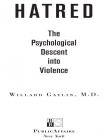Hatred, Willard Gaylin [best ebook for manga txt] 📗

- Author: Willard Gaylin
Book online «Hatred, Willard Gaylin [best ebook for manga txt] 📗». Author Willard Gaylin
Does it really matter whether psychopaths are born or made? They wreak their havoc anyway. When one sees them as agents of evil, how they are made becomes less important. But it certainly matters in the therapeutic and prophylactic world. We must also face up to the fact that a culture may encourage and support psychopathic behavior. It can bring out the paranoid elements of more normal populations. The psychopath is at his most dangerous when he possesses the intellect, the charisma, and the opportunity to fire up larger populations. We know that deceptive psychopaths have taken over large corporations and large nations.
Even when the psychopath does not possess those character traits that open the door to leadership, he can become the hit man, the torturer, or the executor of the policies of the leadership. The danger of the psychopath is compounded when he finds support in a culture of hatred. Then he becomes the agent of the resentments and frustrations, the humiliations and despair of that larger group. He will lead the Klan and run the furnaces at the Nazi death camps and encourage acts of terrorism.
It is sometimes difficult to distinguish the psychotic from the psychopathic. The pure schizophrenic is the easy case. There was a pathetic quality in the schizophrenic demeanor of Lucas Helder—with his serious attempt to create a pattern of “funny faces” out of the bombing sites—that was in sharp contrast to the cold, unyielding, and psychopathic hatred of Timothy McVeigh.
But the extreme psychopath is hard to distinguish from the psychotic, since almost all psychopaths display the marked paranoid traits that are the hallmarks of the paranoid schizophrenic. The organizational abilities and the people skills of Hitler suggest the psychopathic rather than the psychotic. And then there was the fact that the Germans almost universally adored him, actually found him charming. The author and reviewer Naomi Bliven expressed incredulity that the Germans “found charm in a man who gobbled sweets, made disgusting comments on food at the table, engaged in staring matches, bragged about his intelligence, and flew into a rage when anybody questioned one of his statements.” 47 She inferred that their love of Hitler revealed some idiosyncrasy of the Germans themselves.
With Stalin, the call is more difficult. He was universally distrusted and hated. With his readiness to locate enemies everywhere and in every population, he may well have been psychotic, although with his well-honed instincts for self-protection, I am likely to include him among the psychopaths. The behavior of such people as Idi Amin and Pol Pot, even when out of power, certainly suggest the psychopath. The evidence seems clear that the major despots of hatred are primarily psychopaths. Still, both psychotics and psychopaths represent the minority of those who kill with hatred.
When considering the torturers, the leaders of the death camps, the various executors of the policies of the governments of hate, we are certainly not dealing with the insane. Some of them, particularly those who volunteer for torture and murder positions, are clearly psychopaths, that is, lucid thinkers with no moral compass. But the most frightening fact is that horrifying mass crimes of hatred are endorsed, supported, and ultimately acted out by “normal” members of the population.
The “ordinary men” of Reserve Police Battalion 101 carried out a massacre of Jewish mothers and children at Jozefow, Poland, on July 12, 1942. Only a dozen of the 500 police had accepted the offer of a senior officer to be excused from the killing. The effect of the slaughter on the murderers was at first “shattering.” Part of their problem was their lack of experience. In the opening days of the slaughter, they shot freehand at point-blank range. As a result, “the bullet struck the head of the victim at such a trajectory that often the entire skull or at least the entire rear skullcap was torn off, and blood, bone splinters, and brains sprayed everywhere and besmirched the shooters.”48 This put severe emotional stress on the men. One said, “I thought I’d go crazy if I had to do that again.”49 So some changes were made in the procedures. With time and conditioning, the men continued their massacres, and, remarkably, they did not go crazy. They adjusted.
The level of hatred in our modern world is appalling, and the cultures of hatred seem ubiquitous. They are not the products of the deranged. The slaughters in Rwanda and the Sudan—like the destruction of the Armenians by the Turks and the massacre of the Jewish population of Europe by the Nazis—were discharged not by psychotics and psychopaths but by normal members of the population. Not by delusional madmen and conscience-free brutes, but by people like you and me. How does one explain the forces that allow populations of normal people to experience such abhorrence and express such malignant hatred toward other populations of normal people? Here one must look, not to the pathologies of the mind, but to the normal phenomena of group identity and cultural animosities. Here we leave the area of hatred as an emotion and enter the domain of hatred as an attachment.
HATRED
AS AN ATTACHMENT
10
IDENTIFYING THE SELF
Human development—the process by which people emerge from childhood to become the diverse kind of adults we observe—has occupied students of human nature for centuries. Before the emergence of the social sciences, human development was most eloquently, though elliptically, described in literature. Such writers as Dickens, Stendhal, Balzac, Tolstoi, and Twain gave a literary testament to Wordsworth’s assertion that “the child is father of the man.”
Why people behave differently—adopt different values, measure themselves by different standards, embrace aggressiveness or conciliation—has traditionally been attributed to genetic endowment or environmental impact, depending on the biases of the culture. The evidence strongly suggests that overemphasizing either to the detriment of the other is an invitation to disaster.
In the Soviet Union under Stalin the strange concept of equality adopted by the Communists demanded that all children be seen as born with equal potential. The Stalinists’





Comments (0)